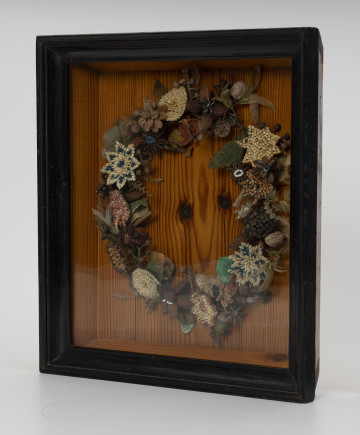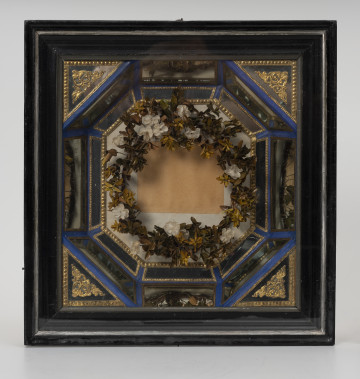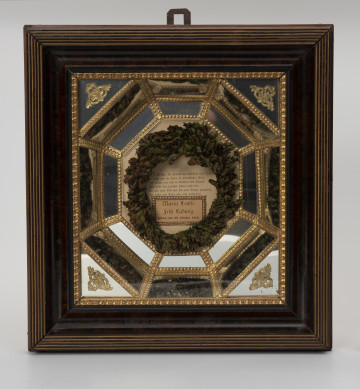
Souvenir wreath in a glass frame
1890 — 1910
National Museum in Szczecin
Part of the collection: European classics of modernity
Włodzimierz Przerwa-Tetmajer received artistic education for over two decades. While attending St. Anne's Gymnasium in Kraków (1873-1881), he took drawing lessons from Józef Siedlecki, a friend of Jan Matejko. From 1875, he attended courses at Kraków's School of Fine Arts, in 1882 he was briefly enrolled in Christian Griepenkerl's Special School of Historical Painting at the Academy in Vienna, and between 1882 and 1886 he pursued regular studies at the Academy in Kraków. His professors were representatives of historicism: Florian Cynk, Leopold Loeffler and Władysław Łuszczkiewicz. Tetmajer also studied classical philology at the Jagiellonian University, where his half-brother Kazimierz, already a famous poet, also studied. Still interested in the same art genre, between 1886 and 1889, the young painter studied under Sándor Wagner at the Academy in Munich and at the Académie Colarossi in Paris. After an imperial scholarship in Rome, he returned to Kraków to take the master class of the national bard Matejko in 1895. Leaving for five years for the summer time to Bronowice Małe, he became associated with the environment of Young Poland peasants fascinated with village life. The apogee of this trend in Polish culture was the premiere of the national drama Wesele [Wedding] (1901) by another of Matejko's pupils, Stanisław Wyspiański. The canvas from the Szczecin collection, created the year the artist left the academy and settled permanently in Bronowice, and the engagement of his brother, is directly connected with the theatre. The works from this series (Scena na ganek w Bronowicach [A Scene on the Porch in Bronowice], 1894; Zaloty [Courtship], 1894) are an excellent artistic representation of Bronowice customs described by Wyspiański, for whom Włodzimierz Przerwa-Tetmajer was the prototype of the character of the Host. The painting, which the painter emphasised in his artistic credo, breaking with his previous achievements, was devoid of literary or historiosophical inclinations. It impresses with its post-Impressionist form and is purely a visual experience.
Szymon Piotr Kubiak
Włodzimierz Przerwa-Tetmajer received artistic education for over two decades. While attending St. Anne's Gymnasium in Kraków (1873-1881), he took drawing lessons from Józef Siedlecki, a friend of Jan Matejko. From 1875, he attended courses at Kraków's School of Fine Arts, in 1882 he was briefly enrolled in Christian Griepenkerl's Special School of Historical Painting at the Academy in Vienna, and between 1882 and 1886 he pursued regular studies at the Academy in Kraków. His professors were representatives of historicism: Florian Cynk, Leopold Loeffler and Władysław Łuszczkiewicz. Tetmajer also studied classical philology at the Jagiellonian University, where his half-brother Kazimierz, already a famous poet, also studied. Still interested in the same art genre, between 1886 and 1889, the young painter studied under Sándor Wagner at the Academy in Munich and at the Académie Colarossi in Paris. After an imperial scholarship in Rome, he returned to Kraków to take the master class of the national bard Matejko in 1895. Leaving for five years for the summer time to Bronowice Małe, he became associated with the environment of Young Poland peasants fascinated with village life. The apogee of this trend in Polish culture was the premiere of the national drama Wesele [Wedding] (1901) by another of Matejko's pupils, Stanisław Wyspiański. The canvas from the Szczecin collection, created the year the artist left the academy and settled permanently in Bronowice, and the engagement of his brother, is directly connected with the theatre. The works from this series (Scena na ganek w Bronowicach [A Scene on the Porch in Bronowice], 1894; Zaloty [Courtship], 1894) are an excellent artistic representation of Bronowice customs described by Wyspiański, for whom Włodzimierz Przerwa-Tetmajer was the prototype of the character of the Host. The painting, which the painter emphasised in his artistic credo, breaking with his previous achievements, was devoid of literary or historiosophical inclinations. It impresses with its post-Impressionist form and is purely a visual experience.
Szymon Piotr Kubiak
Author / creator
Dimensions
cały obiekt: height: 92 cm, width: 151 cm
Object type
painting
Creation time / dating
Creation / finding place
Identification number
Location / status

1890 — 1910
National Museum in Szczecin

1890 — 1910
National Museum in Szczecin

1910
National Museum in Szczecin
DISCOVER this TOPIC
National Museum in Szczecin
DISCOVER this PATH
Educational path